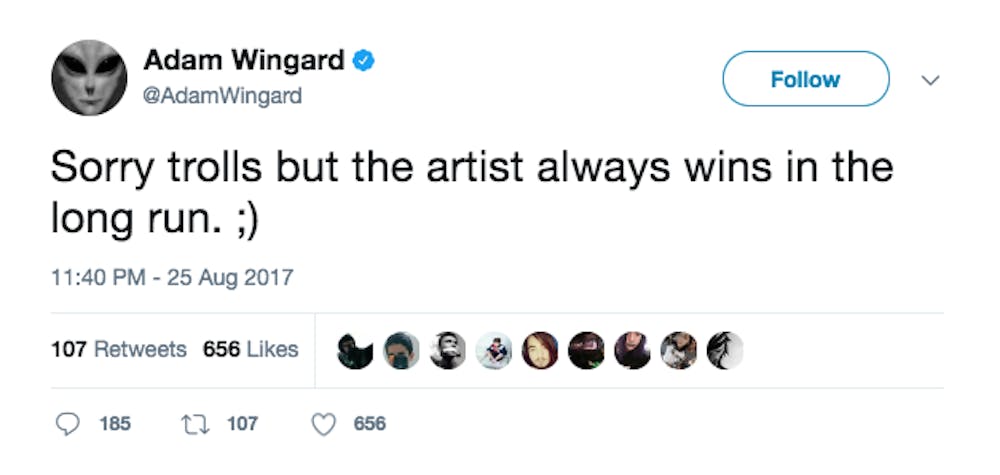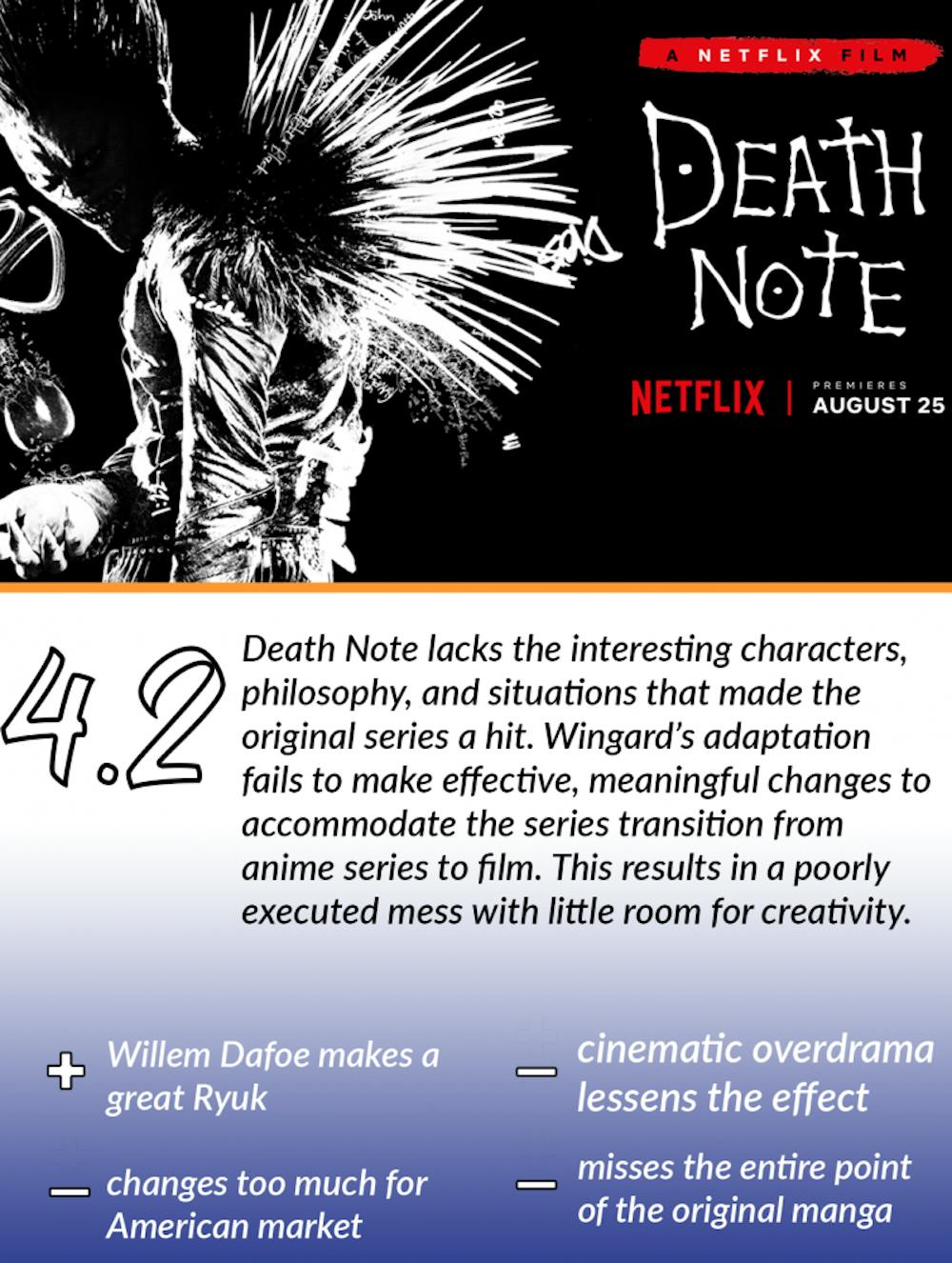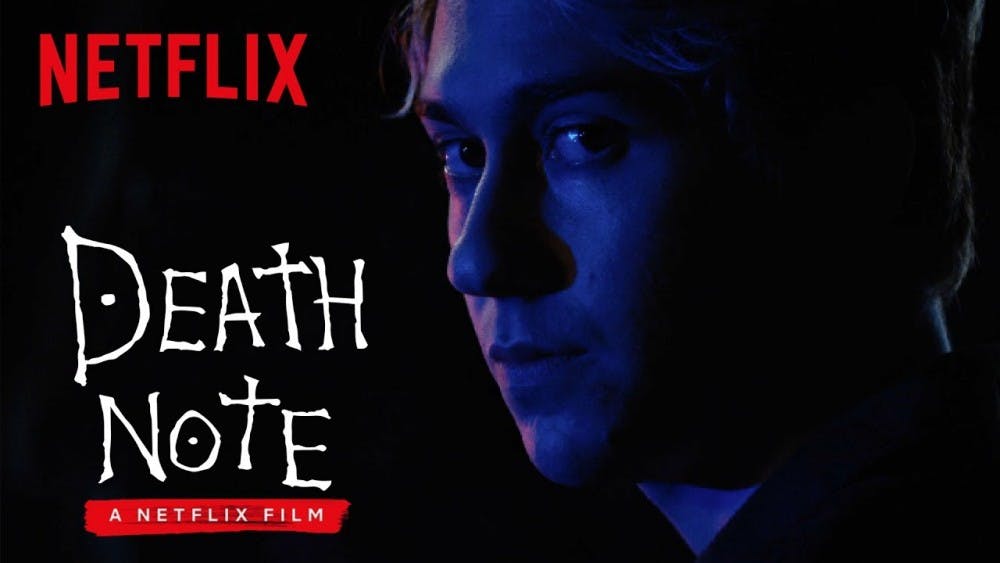The infamous manga Death Note, written by Tsugumi Ohba and illustrated by the impressive Takeshi Obata from 2003 to 2006, became immensely popular for its themes discussing human morality and justice. After the manga’s great success, an anime series was created in 2006 followed by two video games, four live action films, two novels, a television drama, a musical (I’m serious), and a miniseries. Obviously, Death Note is extremely successful and marketable; it can be made in almost any form and consumers will buy into it even if the content is poor in quality.
The Netflix original film, Death Note, is a prime example of both creative liberty gone awry and a failed Western anime adaption. Netflix’s latest film Death Note shows little respect for the ingenious source material it vaguely resembles. Even without taking the original Death Note series into account, Netflix’s recent attempt is ridden with plot holes, ill-defined characters, poor cinematography, and even baffling music choices.
When a killer notebook falls from the sky…
The film begins with a strange montage of high school sports activities with an awkward teen as the center of focus. Light Turner (apparently Light’s actual Japanese name, Yagami, was too edgy for American audiences) is a seemingly smart teen who makes easy money by doing his classmates’ homework.
Just as in the anime, a strange notebook suddenly falls from the sky. Light picks up the notebook titled “Death Note” and proceeds with his day.
After picking up the mysterious notebook, Light tries to help a cute cheerleader, Mia, stop a bully from assaulting another classmate. Light is knocked out and then scolded for being found unconscious with other students’ homework. Light becomes upset that he is being punished for such a trivial crime when the person who had initially assaulted him walks free. This is a personal subject for Light, as he suffers from the ever so common dead mother syndrome that afflicts so many film protagonists.
Light’s mother was apparently killed in an unspecific car accident, and the driver was let off the hook. Because of this troubled past and the recent assault that had also gone unpunished, Light believes that the world is unfair and that there is no morality or justice to be found in the world.
Eventually, a demon-like creature known as Ryuk appears to Light. He persuades Light to use the Death Note to do “great things”. With Mia’s help and Ryuk’s persuasion, Light uses the Death Note to kill criminals, under the alias “Kira”, and eventually becomes revered as a god by those longing for justice in the world. The detective L and his comrade, Watari, begin to hunt down Kira and tensions begin to rise.
Americanized and robbed of all purpose
Well according to the film’s director, Adam Wingard, “the artist always wins in the long run”:

Sadly for Wingard this only holds true if the film is good. And Death Note is not.
Putting the massive deviations from the source material aside (for now), the biggest issue is a lack of motivation given to characters. Their personalities aren’t showcased enough to make their desires clear. Light is the worst offender: he states he wants to stand up for the little guys, but there is very little evidence that Light even cares about anything other than revenge for his mother’s death. We were shown that he was knocked out by a bully, but is this minor high school incident really enough to justify his massive killing spree? He mindlessly kills criminals and there is very little reason why he does this other than “Ryuk said I should, so guess it could maybe be a good thing to kill bad guys”. The show wants us to believe that Light has some complicated, important plan for himself and the Death Note, but he is portrayed more as a misguided high schooler playing around with his new girlfriend, Mia.
Misa Amane, the girl Light manipulates and uses to advance Kira’s powers in the original version, is noticeably absent from the film. Instead she is replaced by the cheerleader Mia, who is so uninteresting she is almost difficult to describe. She, like Light, wants to make the world a better place – how original. That’s her entire character. The audience is given no indication of who she is other than her relationship to Light (if you can call it a relationship), and oddly she takes on a role closer to the anime version of Kira than Light does but without intelligence. Like Kira’s character in the series, she tends to think in terms of the ends justifying the means while Light has some morals, albeit faulty morals. She is presented as stronger, more dedicated, and more ambitious than Light, which makes you wonder why she is given so little character development. Light is denied a chance for character growth largely because half of the character he is based off is given to Mia in an attempt to make him more sympathetic; we can’t have a character do evil things without prompting or dramatic backstory apparently.
Regarding Ryuk, Willem Dafoe is a delight. There is no one else that could have possibly come close to an accurate portrayal of Ryuk while offering a relatively genuine performance. Even his voice resembles that of the anime’s English dub. Sadly Dafoe’s talents are wasted by the ludicrous writing and a presumably poor budget. The strangest change is Ryuk’s personality, which took a complete 180 turn from the anime by turning him into a simple demon rather than a passive, sometimes humorous god of death. It seems that Death Note wanted Light to have an excuse for his murderous actions, so they made Ryuk a manipulative, evil being. By doing so Ryuk really has no end goal other than wanting to mess around with whatever human he can, and in comparison to the Ryuk in the anime or manga, this is simply a boring, uninspired portrayal.
L is hardly present. The most I can say about him is that he is a guy who dresses in all black, sits weirdly, eats sweets, and talks fast. That’s about it. He has very few interactions with Light and his influence is relatively miniscule. It’s baffling how the Death Note’s most popular, unique, and interesting character has little personality or role in the film adaption. Maybe this is for the best; audiences would probably rather see him less than give him enough screen time to ruin the real L’s reputation.
Dutch Angles don’t make you artsy
There are numerous issues with the filmmaking, but to keep this review from becoming a ten-page essay, let’s focus on the most obnoxious aspect of the cinematography: Dutch Angles.
For the record, here is the definition of a Dutch Angle:
”… a technique that involves tilting your camera to one side, resulting in a frame that isn’t level.”
This definition is imperative for understanding a major annoyance with Death Note. When used effectively, a Dutch Angle can communicate unease, tension, and instability. They do not do that in Death Note. Why? They are constant. It is almost like the Director of Photography is trying to say, “OOOOOoooooohhhhh! Look how scary and tense this scene is!” The problem is that the Dutch Angles used here are so prominent and happen so often that their effectiveness is almost instantly destroyed. They happen in car chases. They happen when we see a character’s childhood home. They happen in a spooky, scary Ryuk scene. They happen during random conversation. They even happen during a game of basketball. Basketball.
A good cinematographer knows how to move the camera effectively and with purpose. In Death Note there is such a lack of purpose and tension in the dialogue and circumstances surrounding the characters that these Dutch Angles are desperately thrown in to add superficial emotion. This is not good filmmaking.
For all you aspiring filmmakers, skewed camera angles don’t automatically make a film creative. In fact when these camera techniques are not well utilized, they come off as simple, lazy, and misguided.
Adaptations don’t have to be bad… but this one is.
They say a picture conveys a thousand words, so I suppose a scene conveys a million. Rather than explain the differences in execution between the anime and Netflix movie, it is far easier to compare scenes.
Here is the scene from the anime when Light first meets Ryuk.
Now here is how the Netflix version introduces Ryuk.
Now to be clear, a different interpretation of a work does not automatically mean it will fail and change doesn’t have to be negative. Oftentimes change from the source material is necessary to convey a coherent story when switching audiences and mediums. However, the changes made for the Netflix version of Death Note show a clear misunderstanding of the source material. I think the examples above demonstrate this, as the tone, musical choices, character portrayals, angles, lighting, and every aspect within the frame of the original vastly outshines the Netflix version.
The manga and subsequent anime were both highly praised for the brutal, honest discussion of what constitutes justice. Light Yagami (not Turner) is an ambitious, nearly perfect human being that, by pure chance, happens upon the Death Note. Despite Light’s near perfect morality, grades, and home life, he is corrupted by the notebook despite his initial noble goal of cleansing the world from evil. After his first kill Light grapples with the gravity of his actions and the morality associated with them. In the end he determines that he will become a martyr and sacrifice his soul for the good of humanity. At this point many viewers empathized with Light’s dramatic stance; there are many bad people who deserve to die. However, Death Note also allowed its viewers to watch the decaying of Light’s humanity as he quickly took to killing for his own gain (something he had sworn he would never do), lying to his family, and manipulating. In becoming a god, Light became a monster.
The Netflix interpretation never allows Light Turner to go through this transition. He is always portrayed as a kind of loser, so his actions are indicative of some deeper emotional distress, and even that is a stretch based on the poor writing and character portrayal. As stated previously, despite the show stating Turner is motivated by his mother’s murder, he comes off as a high schooler run amok. Because of this the ultimate message of the original series is lost. In the original it is apparent that even good people can be responsible for terrible, evil things if given the opportunity. The definition of justice is blurred as various interpretations of what constitutes justice come into question. L and Light’s clashing ideas of justice make them foils for one another; Light perceives justice as something to be obtained at the cost of violating societal rules and expectations, while L defines justice as adhering to those rules. This is a far more complex philosophy and character relationship than anything portrayed in the Netflix film.
It doesn’t work as an adaptation or a standalone film…
Creative liberty is often deployed as an excuse for botched film adaptations. Ideas can change; established stories can be reimagined; and elements of these stories can be improved from the source material. Absolutely. Creativity is only limited by the individual. Sadly most individuals only search for easy cash grabs with little respect for the source material, and Netflix’s Death Note seems to be a clear example of this. Anime adaptions are especially tricky in this regard, especially when geared toward a Western audience with little connection to Japanese references, culture, humor, social norms, and ideologies that are prevalent within the anime genre. As a result Death Note is a clunky mess that lacks the creative characters and philosophy that had made the series famous in the first place. In an attempt to appeal to a more Western audience, Death Note appeals to no one.

All images from Facebook, Twitter, and IMDb
For more entertainment related content, visit us at Byte Bsu!




















